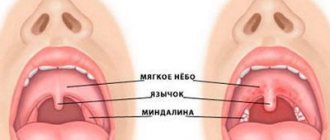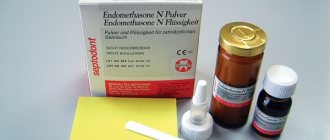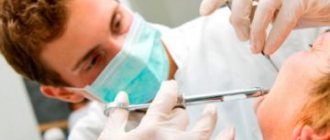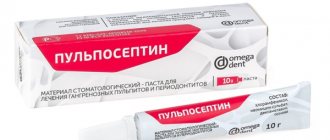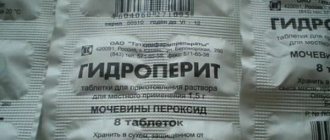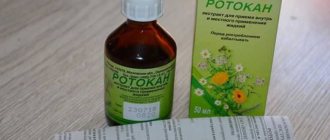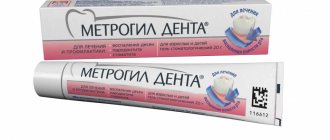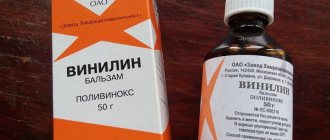How to care for teeth after implantation is a question that is no less important than the process of prosthetics itself. Installing a pin under a crown is not an easy process; it is often accompanied by pain and a long recovery period. It is rehabilitation that plays a key role not only in the survival of the implant, but also in the service life of the future prosthesis, because every patient wants to keep new teeth for as long as possible without health consequences.
Proper oral care after implantation is the key to successful prosthetics.
How is the drug released?
There are several different forms of release of the drug. This allows you to choose the most convenient option for use for each individual patient. It is better to rinse your gums with Miramistin in the form of a solution, and, for example, use the ointment during the treatment of herpetic manifestations on the skin.
Solution
One of the most effective and convenient forms of the drug. Proper use allows you to cover the entire inflamed part of the gum or mouth. In addition, the solution can be used not only for rinsing, but also for making lotions and performing douching and wiping. The downside is that it is difficult to use for treating young children, since it is difficult for them to keep the liquid in their mouth and not swallow. For kids, it is better to choose other release options.
Spray
This is the same antiseptic solution, only the packaging is different. A special nozzle on the lid allows you to spray the medicine in hard-to-reach places on the gums, for example, when treating a small child who cannot rinse his mouth on his own. In this method, it is not always possible to cover all problem areas with Miramistin, unlike rinsing, when the entire oral cavity is susceptible to antiseptic influence.
Ointment
Miramistin in the form of an ointment is not used for gum inflammation, since this form is practically not fixed at the site of application, and there is a risk of swallowing the drug. In addition, the components of the ointment affect only the upper balls of the gums, without penetrating into deeper structures, so the therapeutic effect is practically absent. Ointment forms will be appropriate for the treatment of herpetic rashes on the skin.
Brief characteristics of the drug
Miramistin is an antiseptic intended for topical use. The drug has no color or foreign odors. The main active ingredient of the drug affects the cellular structure of microbes and destroys them. Miramistin effectively fights the following types of bacteria:
- staphylococci,
- streptococci,
- gram-negative bacteria,
- anaerobic and aerobic,
- immunodeficiency viruses,
- fungal infection pathogens.
The drug is available in the form of ointment, spray and solution. Use the solution to gargle. With this remedy you can reduce swelling and inflammation in the throat, prevent purulent formations and complications. The medicine promotes rapid healing of wounds. Miramistin will also help cope with stomatitis, herpes, and caries.
Miramistin, as a rule, does not cause allergic reactions. Very rarely, the patient experiences a burning sensation in the treated area. This is possible with individual intolerance. The medicine is approved for use by children from three years of age, pregnant and lactating women.
Scope of application and characteristics of antiseptic
The medicinal and prophylactic drug is an effective antiseptic, ideal for treating the larynx and oral cavity. For these purposes, a solution form is used. Miramistin is a transparent, odorless and colorless liquid preparation. It foams when shaken. Composition of the product:
- benzyldimethyl ammonium chloride monohydrate;
- additional component – distilled water.
To rinse the mouth with Miramistin, the child must be able to gargle. Otherwise, you should use a spray form, irrigating the inflamed mucous membrane of the baby’s throat.
Solution:
- in no case is it absorbed into the mucous membranes;
- does not violate local immunity;
- does not irritate the skin;
- does not affect the functioning of internal organs in any way;
- does not penetrate into blood vessels.
Therefore, Miramistin is used without restrictions in children of different ages and in pregnant women.
Experts recommend gargling with Miramistin for preventive purposes. This can be done once a day during epidemics of acute respiratory infections, acute respiratory viral infections, influenza, or if there is a patient in the house who has already become infected with acute viral or infectious colds. Miramistin will eliminate sore throat and painful sensations.
The product will reduce swelling of the mucous membranes and destroy pathogens:
- sore throats,
- stomatitis,
- tonsillitis,
- laryngitis,
- pharyngitis.
The antiseptic promotes the rapid healing of small wounds in the oral cavity. Preventive rinsing is recommended for children starting from 5 years of age, as well as for adult patients.
The pharmaceutical industry produces medicine in the form of a 0.01% solution, ointment, spray. The medicine is intended for local use.
This drug belongs to the group of antiseptics. To treat the throat and oral cavity, Miramistin is used in the form of a solution that is odorless and colorless, foaming when shaken. The medication consists of the active substance benzyldimethyl ammonium chloride monohydrate and an additional component – distilled water.
The main substance of Miramistin acts directly on the cellular structures of microbes. While destroying and leading to the death of the cells of pathogens, the antiseptic does not have a negative effect on healthy cells.
The medicine is not absorbed through the skin and mucous membranes. The drug does not affect the functioning of internal organs and does not penetrate the bloodstream. Allowed for pregnant women during breastfeeding and children from infancy.
Miramistin has a detrimental effect on pathogenic microorganisms:
- Bacteria of all types (staphylococci, streptococci, gram-negative, anaerobic, aerobic).
- Virulent fungi.
- Human immunodeficiency viruses and viruses that cause herpes.
- Microorganisms that cause diseases that are transmitted through sexual contact.
Miramistin is a broad-spectrum drug that affects pathogens of viral, fungal, and bacterial infections. It is used as an antiseptic in the fight against nosocomial infections. This product activates local immunity and has a regenerative effect on the affected areas.
- When relieving inflammation in the oral cavity, complex treatment of stomatitis caused by a herpetic virus, disinfection of removable dentures is carried out using this drug.
- In the treatment and prevention of purulent inflammatory processes in muscles and bones in surgery and traumatology.
- Used in gynecology and obstetrics to prevent postoperative events.
- Urologists effectively carry out anti-inflammatory therapy with Miramistin for diseases of the urethra.
- The medication is widely used in skin and venereal disease clinics for the treatment of pathological conditions caused by fungi and for the prevention of sexually transmitted diseases.
- Miramistin is prescribed for the treatment of various forms of burns and sanitary treatment of burn lesions before plastic surgery.
- A wide range of diseases of the ear, nose and throat of inflammatory origin are treated with this medicine in otorhinolaryngology.
Despite the wide spectrum of action, Miramistin, due to its medicinal properties, is one of the most effective drugs in the treatment of dental and otolaryngolic pathologies.
Medicinal solutions for rinsing teeth and gums
You will achieve greater results if you start using an irrigator to rinse your gums - a device that delivers liquid into the oral cavity under pressure. For this purpose, it is best not to use self-prepared rinses based on medicinal herbs, which can clog the filter, but to use ready-to-use pharmaceutical medicines for rinsing the gums.
Chlorhexidine
The use of chlorhexidine for rinsing gums is common in dentistry. It effectively copes with the symptoms of inflammation and has an affordable price. Patients are often interested in the question: how to dilute chlorhexidine? In this case we are talking about an aqueous 0.05% solution, so dilution with water is not required. It is recommended to use after each meal and for at least one minute.
Rotokan
For rinsing, rotokan is used in the form of an alcohol tincture based on plant extracts at least 3 times a day. You will need 1 teaspoon of the product per 200 milliliters of boiled warm water. Do not swallow!
Furacilin
Furacilin for rinsing gums is most often used in tablets: crush 1 tablet, pour a glass of hot water until completely dissolved, cool to body temperature and rinse your mouth after eating.
Stomatophyte
An alcohol tincture containing extracts of 7 medicinal plants. Requires dilution with water at the rate of 1 measuring cup per 50 milliliters of warm boiled water. Rinsing with Stomatofit is prescribed 3 times a day. Not suitable for children under 12 years of age!
Miramistin
Rinsing the gums with Miramistin is carried out at the rate of 10 milliliters of solution per 25 milliliters of boiled water. You should not eat for an hour after the procedure. Use as a mouth rinse for no longer than 5 days in a row, otherwise Miramistin begins to inhibit the beneficial microflora in the mouth.
Chlorophyllipt
Chlorophyllipt for rinsing is used in the form of an alcohol solution based on a strong natural antiseptic - eucalyptus extract. It is recommended to use it no earlier than half an hour after meals, preparing a mouthwash at the rate of 1 tablespoon per glass of warm water.
How the drug works
This drug is a drug that has a bactericidal effect when applied topically. Numerous studies have proven that the product is effective against most known pathogens of stomatitis - it affects bacteria, pathogenic fungi, and most viruses that can damage the mucous membrane.
At the same time, the active substance of the drug does not interact with the epithelium lining the oral cavity and does not damage the cell structure.
The medicine has a huge advantage - the drug is sold in pharmacies, ready for use, and it can be used as prescribed by a doctor without any additional manipulations. You do not need a prescription to receive Miramistin.
Miramistin
Miramistin is an antiseptic drug for local and external use. Endowed with a wide spectrum of antibacterial action, including nosocomial microbial strains resistant to antibiotics. The drug has a pronounced bactericidal (destructive for bacteria) effect on gram-positive (Staphylococcus spp., Streptococcus spp.) and gram-negative (Escherichia coli, Klebsiella spp., Pseudomonas aeruginosa) bacteria. It has a fungicidal effect on ascomycetes of the genera Penicillium and Aspergillus, yeast (Torulopsis gabrata, Rhodotorula rubra) and yeast-like (Candida albicans, Candida krusei, Candida tropicalis, Malassezia furfur, Pityrosporum orbiculare) fungi, dermatophytes (Epidermophyton Kaufman-Wolf, Epidermophyton floccosum, Microsporum canis , Microsporum gypseum, Trichophyton mentagrophytes, Trichophyton rubrum, Trichophyton schoenleini, Trichophyton violacent, Trichophyton verrucosum) and other monocultures and associations of pathogenic fungi, including fungal microflora with resistance to chemotherapy drugs. It has antiviral activity against complex viruses (human immunodeficiency virus, herpes viruses, etc.). The drug also acts on pathogens of sexually transmitted infections (Neisseria gonorrhoeae, Chlamydia spp., Trichomonas vaginalis, Treponema spp., etc.). Effectively prevents infections of burns and open wounds. Stimulates recovery processes. Activates the occurrence of protective reactions at the site of direct use due to the activation of phagocytosis. The presence of pronounced hyperosmolar activity in Miramistin gives the drug a number of useful properties. Thus, this antiseptic is able to reduce wound and peri-wound inflammation, absorb purulent exudate, promoting the formation of a dry scab. At the same time, miramistin does not damage granulations and normal skin cells, and also does not suppress marginal epithelialization. The drug does not have irritant or allergen properties. When used topically, Miramistin is not absorbed by the skin and mucous membranes and does not enter the systemic circulation.
When used in traumatology, combustiology, surgery for therapeutic and prophylactic purposes, wound and burn surfaces are irrigated, wounds and fistula tracts are tamponed, and gauze swabs soaked in miramistin are secured. This procedure is carried out 2-3 times a day for 3-5 days. One of the most effective is the method of active drainage of wounds with a daily consumption of the drug up to 1 liter. When used in obstetric and gynecological practice, in order to prevent postpartum infection, vaginal irrigation is performed for 5-7 days before childbirth and in the postpartum period. The consumption of the drug for one such procedure is 50 ml, the exposure time is 2 hours. If the birth took place by cesarean section, then immediately before the surgical intervention the vagina is treated, during the procedure the uterine cavity is treated along with the incision made, and after the operation tampons moistened with miramistin are inserted into the vagina for 2 hours every day for 1 week. Treatment of diseases of inflammatory origin is carried out in the form of two-week courses by introducing tampons into the vagina and/or through medicinal electrophoresis. To prevent sexually transmitted diseases, Miramistin will be effective if it is used no later than 2 hours after sexual intercourse. To do this, using the included urological applicator, the contents of the bottle are introduced into the urethra for 2-3 minutes: 2-3 ml (for men), 1-2 ml and an additional 5-10 ml into the vagina (for women). The skin of the inner thighs, peripubic area and external genitalia is also treated. After this procedure, it is recommended to refrain from urinating for 2 hours. In combination therapy for urethritis, Miramistin is injected into the urethra 2-3 ml 1-2 times a day for 10 days. For inflammation of the oral mucosa and gums, as well as for periodontitis, Miramistin is used in the form of mouth rinses of 10-15 ml of solution 3-4 times a day.
How to use Miramistin in dentistry and what contraindications does the drug have?
Miramistin is a pharmacological drug based on benzyldimethyl ammonium chloride.
This substance was developed by scientists from the Soviet Union and was originally planned to be used for surface disinfection of spacecraft and satellites.
But since the 90s, it has been actively used in medicine as an antiseptic with a wide spectrum of action (destroys both bacteria and fungi).
This is interesting: How and with what to brush teeth for 1-year-old children - technique, training, children's products
How is Miramistin used in dentistry?
Pros and cons of the drug
The key advantage of Miramistin is that it is active against most gram-positive and gram-negative bacteria, including those resistant to antibiotics, as well as against ascomycete fungi, yeasts, and dermatophytes.
The drug is characterized by an antiviral effect (including against those that cause sexually transmitted diseases).
And at the same time, Miramistin accelerates wound healing and enhances the local immune response (by stimulating phagocytosis).
The active substance is insoluble, therefore drugs based on it are produced in the form of aqueous, alcoholic solutions, ointments, gels and even powder for the preparation of a saturated concentrate (not currently sold).
It does not penetrate the mucous membrane or the upper layer of the epithelium, so it can be used even during pregnancy - this substance is not absorbed into the blood.
Among the disadvantages, one can highlight only the aggressive effect on microflora, which is why it should not be used in dentistry for more than 5-7 days. Otherwise, the concentration of beneficial bacteria on the oral mucosa will significantly decrease, which increases the risk of developing stomatitis.
Indications
According to the official instructions, the indications for the use of Miramistin in dentistry are:
Doctors also recommend using Miramistin for regular hygienic cleaning of removable dentures or after tooth extraction (to speed up wound healing and prevent bacterial damage).
Miramistin can also be used to treat inflammatory diseases, including laryngitis and tonsillitis.
Rules of application
In dentistry, Miramistin is used as a rinse.
It is prepared at the rate of 10-15 milliliters of the drug per 25-40 milliliters of boiled, cooled water.
The mouth is rinsed with this composition 3-4 times a day.
After treating the gums and mucous membranes with Miramistin, you should refrain from drinking, eating and smoking for at least 60-90 minutes (optimally 2 hours). The permissible course of therapy is up to 7 days, then only with the direct prescription of the attending physician.
The medicine is also applied using a tampon to areas of inflammation in the gum area. They are also used to make bandage compresses for treating wounds after tooth extraction - this will speed up the healing process. Such tampons are applied only after the blood clot has “hardened”.
Miramistin can also be used by a doctor to treat the junction of a denture and gums. To do this, a thread soaked in a medicinal solution is placed in the subgingival pocket.
Miramistin solution with gynecological attachment 0.01% 50 ml ➤ instructions for use
The drug is ready for use. Instructions for using the packaging with spray nozzle:
1. Remove the cap from the bottle and also remove the urological applicator from the 50 ml bottle.
2. Remove the supplied spray nozzle from its protective packaging.
3. Attach the spray nozzle to the bottle.
4. Activate the spray nozzle by pressing again.
Directions for using the 50 ml or 100 ml pack with gynecological attachment:
1. Remove the cap from the bottle.
2. Remove the supplied gynecological attachment from the protective packaging.
3. Attach the gynecological attachment to the bottle without removing the urological applicator.
Otorhinolaryngology.
For purulent sinusitis, during puncture the maxillary sinus is washed with a sufficient amount of the drug.
Tonsillitis, pharyngitis and laryngitis are treated by gargling and/or irrigation using a spray nozzle, pressing 3-4 times, 3-4 times a day. The amount of drug per rinse is 10-15 ml.
In children. In case of acute pharyngitis and/or exacerbation of chronic tonsillitis, the pharynx is irrigated using a spray nozzle. Children aged 3-6 years: by pressing the head of the spray nozzle once (3-5 ml per irrigation), 3-4 times a day, for children aged 7-14 years by pressing twice (5-7 ml per irrigation) , 3-4 times a day, for children over 14 years of age, by pressing 3-4 times (10-15 ml per irrigation), 3-4 times a day. Duration of therapy
ranges from 4 to 10 days, depending on the timing of remission. Dentistry.
For stomatitis, gingivitis, periodontitis, it is recommended to rinse the mouth with 10-15 ml of the drug, 3-4 times a day.
Surgery, traumatology, combustiology.
For preventive and therapeutic purposes, the surface of wounds and burns is irrigated, wounds and fistula tracts are loosely tamponed, gauze swabs soaked in the drug are fixed. The treatment procedure is repeated 2-3 times a day for 3-5 days. A highly effective method of active drainage of wounds and cavities with a daily consumption of up to 1 liter of the drug.
Obstetrics, gynecology.
In order to prevent postpartum infection, it is used in the form of vaginal irrigation before childbirth (5-7 days), during childbirth after each vaginal examination and in the postpartum period, 50 ml of the drug in the form of a tampon with an exposure of 2 hours, for 5 days. For the convenience of vaginal irrigation, the use of a gynecological nozzle is recommended. Insert the contents of the bottle into the vagina using a gynecological nozzle and perform irrigation.
When women give birth by cesarean section, the vagina is treated immediately before the operation, the uterine cavity and the incision on it are treated during the operation, and in the postoperative period tampons soaked in the drug are inserted into the vagina with an exposure of 2 hours for 7 days. Treatment of inflammatory diseases is carried out over a course of 2 weeks by intravaginal administration of tampons with the drug, as well as by the method of medicinal electrophoresis. Venereology.
For the prevention of sexually transmitted diseases, the drug is effective if it is used no later than 2 hours after sexual intercourse. Using a urological applicator, insert the contents of the bottle into the urethra for 2-3 minutes: for men (2-3 ml), for women (1-2 ml) and into the vagina (5-10 ml). For convenience, the use of a gynecological attachment is recommended. Treat the skin of the inner thighs, pubis, and genitals. After the procedure, it is recommended not to urinate for 2 hours.
Urology.
In the complex treatment of urethritis and urethroprostatitis, 2-3 ml of the drug is injected into the urethra 1-2 times a day, the course is 10 days.
Features of use
Miramistin must be spat out after treatment of the oral cavity, but in case of accidental ingestion, there is no need to worry.
People who have been diagnosed with a catarrhal form of gastritis, provoked precisely by an imbalance of the positive microflora of the gastrointestinal tract, should use the solution more carefully.
During dental treatment of teeth, gums or oral mucosa, a burning sensation may occur - this is a normal reaction. You just have to remember that the drug should be used only for local treatment. Accordingly, if it is necessary to act exclusively on a small area of the gum, then it is better to use a tampon rather than completely rinse the oral cavity.
For children
According to the official instructions, Miramistin can be used from 3 years of age.
Pediatricians recommend using it as a spray, that is, spraying it on the mucous membranes of the mouth, gums, and teeth.
Another option is to use a silicone toothbrush soaked in Miramistin (at the rate of 15 milliliters of water and the 0.01% solution itself).
You can buy a special finger brush in pharmacies. Up to 3 years, Miramistin is used only as prescribed by a doctor and under his supervision.
During pregnancy
There are no restrictions during pregnancy regarding the use of Miramistin. But to prevent an allergic reaction, a hypersensitivity test is performed before using it. To do this, apply a few drops of the solution to the skin in the wrist area (where the pulse can be measured) and rub thoroughly.
If no allergic reaction occurs within 10-15 minutes (inflammation, redness, blistering, rash), then Miramistin can be used according to the instructions for use.
During lactation, the use of Miramistin is also allowed.
How to rinse your mouth with Miramistin after tooth extraction
In the first 1–2 days after extirpation, any rinsing is prohibited. Otherwise, you can wash the clot out of the well. If an infection gets into it, alveolitis or osteomyelitis will begin. In the first case, the socket becomes inflamed, in the second – the bone. That's why they only do baths. Take one sip (10–15 ml) of liquid at room temperature into your mouth, hold it for 1–2 minutes and spit it out.
Next, you should adhere to the following rules:
- Starting from the 3rd–4th day, you can carry out gentle rinsing. To do this, you need to tilt your head several times from the side of the extracted tooth to the healthy one.
- Baths and rinses are carried out immediately after meals.
- After treating the oral cavity with Miramistin for 1–1.5 hours (optimally up to two), you should refrain from smoking, drinking and eating.
In most cases, patients are prescribed 3-4 rinses per day. The course of treatment is up to a week.
After tooth extraction, patients should also pay special attention to oral care. If you are concerned about whether it is possible to do ordinary hygienic rinses, then you should also avoid them at first. In order to maintain hygiene, patients are recommended to use the same baths. To do this, take warm water into your mouth, hold it a little and spit it out. And so several times until you feel fresh.
Side effects and contraindications
Side effects from using the drug include the risk of developing an allergic reaction. It occurs very rarely and most often affects young patients. A burning sensation may occur during use. This phenomenon is considered normal and does not require refusal from further use.
Contraindications include individual intolerance of the body to the components of the drug, which occurs in the presence of certain types of allergies and dermatitis. In any case, Miramistin should be taken under the supervision of a specialist.
Features of rinsing your mouth with an antiseptic
Experts recommend gargling with Miramistin for preventive purposes. This can be done once a day during epidemics of acute respiratory infections, acute respiratory viral infections, influenza, or if there is a patient in the house who has already become infected with acute viral or infectious colds. Miramistin will eliminate sore throat and painful sensations. The product will reduce swelling of the mucous membranes and destroy pathogens:
The antiseptic promotes the rapid healing of small wounds in the oral cavity. Preventive rinsing is recommended for children starting from 5 years of age, as well as for adult patients.
Treatment of throat in infants
The instructions for use say that Miramistin is prohibited for use in patients under 12 months of age. This is because the drug has not been tested on infants, and therefore their reaction is unknown. However, many doctors claim that the antiseptic is safe if the dosage and rules of use are followed.
For the treatment of patients under 12 months, an aerosol is often used. This dosage form is the most convenient and safe for infants.
The nebulizer directs the jet precisely to the affected area, while maintaining the appropriate dosage and concentration of the drug. The drops act on individual areas of the mucous membrane, and the spray is evenly distributed over the entire infected area.
The daily dose of Miramistin for the throat is 1 injection 2 times. The decision to increase the frequency of administration is made by the attending physician.
The difficulty of using the drug for newborns up to 12 months is that the baby cannot help the parents and does not understand what is happening. Therefore, adults should adhere to the following recommendations:
- It is necessary to carefully insert the spray into the baby's mouth and irrigate the inner lining of the cheeks or tongue.
- In order for the medicine to penetrate to the source of infection, the spray is applied not to the throat, but to the pacifier. Before the procedure, the pacifier is disinfected, and after irrigation it is placed in the baby’s mouth.
Usually the procedure does not cause stress in newborns, since the medication has a neutral color and odor. The active component is mixed with saliva, penetrates into the site of inflammation, where it begins to act.
It is strictly forbidden to independently increase the dose of medication for children under 1 year of age. This threatens with soreness and drying out of the mucous membrane. In addition, there is a risk of accidental ingestion, after which the functioning of the stomach is disrupted.
Miramistin for the throat exhibits a therapeutic effect already on the second day of use.
How to rinse your mouth with miramistin for gum inflammation?
To rinse, you need to put 15 ml of undiluted Miramistin in your mouth and start the procedure. When rinsing, it is important to ensure that the gums come into contact with the antiseptic. After rinsing, the drug should be spat out.
This is interesting: Rinsing with soda and salt for inflammation of the gums and teeth
Doctors recommend repeating the procedure twice a day for 10 days until the inflammation is eliminated.
Is Miramistin effective for stomatitis?
The drug has antimicrobial and bactericidal properties, destroying gram-negative and gram-positive microflora. Under the influence of Miramistin, the proliferation of fungi is inhibited, stopping the development of the disease. The medicine helps to form an adequate and correct immune response. As a result:
- local immunity significantly enhances its protective properties;
- the infection stops spreading to healthy tissue;
- already damaged tissues are restored faster;
- the drug helps to adsorb (collect) pus and remove waste products of pathogenic microorganisms;
- stops inflammatory processes.
A big advantage of the drug is its good compatibility with other antibiotics that are taken to increase tissue regeneration, as well as the taste of the drug. Many medications that are intended for treating the oral cavity are produced with an unpleasant taste. This becomes a problem when using them for children. Reflex vomiting and increased salivation can create a dangerous situation for the child’s health. Miramistin is distinguished by the absence of antipathetic odors and tastes. The solution is more similar in taste to plain water, which greatly simplifies the procedure for using it for children.
The drug is also suitable for preventive purposes when one of the family members already has the problem. To do this, the oral cavity is sprayed with Miramistin solution 2 times a day, but the drug cannot be used for more than 10 days.
The use of the drug does not always guarantee a positive result in treatment. Miramistin will not bring the expected result for allergic stomatitis. Treatment may fail if the disease is caused by dental problems. These include: the presence of periodontal disease or tartar, advanced caries, as well as the presence of other inflammatory processes. First you need to eliminate the original cause. Then just start fighting stomatitis.
Prevention and treatment of alveolitis after tooth extraction
A rinse solution is used. It is used 2-4 times during the day, the course of administration should not exceed a week, a maximum of 10 days.
Miramistin for a fistula on the gum is prescribed for rinsing the canal, and then for rinsing the entire oral cavity. The frequency of use depends on the severity of the disease, but it is not recommended to use the drug for more than two weeks.
Use for toothache
Often after tooth extraction, the doctor prescribes rinsing with various antiseptic solutions. The primary goal of this procedure is to prevent wound infection. But in addition to this, Miramistin has an anti-inflammatory effect, affecting the symptoms of the pathological process. One of the symptoms of inflammation is pain. The drug also saves from it.
Almost no one prescribes this remedy as a first-line fighter against toothache. In most cases, this is done to prevent the development of this unpleasant syndrome.
In what cases is rinsing with Miramistin prescribed:
- After the retraction. Tooth extraction can be performed against the background of an inflammatory process. The procedure may be complicated due to an inconvenient location in the hole or doctor errors. In such cases, to prevent the development of alveolitis, rinsing with this solution is prescribed. The course lasts up to 10 days, during which time you need to perform oral baths 2-3 times daily.
- In the treatment of gum or periodontal inflammation. Therapy for gingivitis and periodontitis should begin with eliminating the main causes and factors leading to their occurrence. To do this, professional hygiene is initially carried out, after which, ideally, you should give up smoking and other bad habits. Immediately after the procedures, the doctor prescribes a course of rinsing, which may include not only rinsing with the solution in question, but also applying another drug, Cholisal gel.
- In the treatment of stomatitis. Dentists note that this is one of the best remedies for this pathology. It quickly suppresses the activity of viruses, which leads to suppression of their condition and a gradual decline in the disease.
These are the most common oral applications. If the patient has any other indications, the doctor will definitely tell you about it and prescribe a course of this drug.
What medications should I take after implantation?
A toothbrush and mouthwash are not always enough to protect yourself from unpleasant consequences. Antibiotics after implantation are a necessary measure, but a comprehensive rehabilitation course also includes taking other medications and multivitamin complexes:
- Amoxiclav or femoclave – 1 capsule 3 times a day for a week. An optimal antibiotic composition that facilitates recovery when building up bone tissue or installing more than two pins at the same time.
- Erius is an antihistamine recommended for the first three days after surgery; it does not cause drowsiness or allergies. 1 tablet per day is enough.
- Nurofen, Nise and analogues among painkillers. The dosage is prescribed strictly individually, based on the patient’s complaints, the degree of swelling of the face, etc. In most cases, 1-2 tablets 2 times a day are sufficient.
- Linex - capsules with active bacteria, reduce the effect of the antibiotic on the intestines, normalize digestion. Up to 3 times a day for two weeks or a month.
- Tantum Verde solution is a gentle antiseptic, which is recommended to be used in gum baths 5-6 times a day until the sutures are removed.
- Ascorbic acid, calcium complex and other mineral and vitamin supplements for general strengthening of the body.
- Kamistad, cholisal and solcoseryl - dental gels and ointments. They are applied topically for both an antiseptic effect and pain relief. Some contain lidocaine, which may cause intolerance.
Any drug should be taken in strict accordance with the prescribed dosage. Ideally, once every one to two weeks until the installation of the prosthesis, you need to visit not only the dentist, but also a therapist in order to record all changes in the condition of the body .
How to use the product correctly?
The best results are achieved by rinsing. At first glance, the rinsing procedure seems quite simple, but not everyone knows the specifics of using Miramistin. An important rule is to follow the prescribed dose, taking into account the patient’s age. Do not forget that this is a medicine, and not a simple medicinal tea.
It is important to strictly follow the instructions for the drug
Sequencing
To achieve the desired effect, you should follow several rules.
| Rule | Description |
| Dosage | Do not under any circumstances exceed the dosage of the drug. Children under 14 years of age need to dilute the liquid with water (2-3 tablespoons). |
| Proper rinsing | While rinsing, you need to tilt your head back slightly. Microorganisms along with the drug can accidentally penetrate the nasal passages, which will only increase the number of existing problems. In the worst case, you can “earn” otitis media. Gargling should be done very carefully. There is no need to blow bubbles, hiss and strain your throat like a small child. This will not increase the effect of Miramistin. When rinsing, try to keep the lower jaw slightly forward. This way, the Miramistin composition will be able to penetrate hard-to-reach places. |
| Swallowing medication | Do not swallow the product after rinsing. A person will not get poisoned this way, but you should not bother your stomach with unnecessary chemicals. The product must be spat out. |
| Storage | You should not store the product in the refrigerator - the storage location should be maintained at room temperature. Half an hour after rinsing, you should not eat or drink water or other liquids. Otherwise, the film of the medicine along with the food will end up in the stomach, and the effect will be zero. You need to wait for Miramistin to begin its anti-virus action, which begins 10 seconds after rinsing. |
| Treatment frequency | It is recommended to rinse your mouth for 2-4 minutes 2-3 times a day. For children, 30-40 seconds will be enough. The treatment course with an antiseptic lasts from 5 to 7 days. If during this period the patient does not notice any improvement, it is worth re-making an appointment with the attending physician to prescribe a new treatment. |
It is important to rinse your mouth correctly
The recommendations are quite simple and will not cause difficulties if you follow them. Do not forget that any microorganisms can adapt to any conditions. At some stage of the disease, the effect of the drug may stop. To prevent this from happening, you should alternate rinsing with an antiseptic and herbal infusions or soda-saline solution.
Dissolve 3 potassium iodine and 1 tsp in 1 glass of warm purified water. soda and salt. Stir everything well and leave to infuse for 15 minutes, after which you can use the product for its intended purpose.
Infusions of sage or chamomile also do not conflict with Miramistin. Alternating them will help achieve the desired result.
This is interesting: Teeth whitening trays with gel: an overview of the advantages and disadvantages
You can alternate rinsing with Miramistin and herbal infusions
Recommendation ! Along with the antiseptic, a special nozzle should come in the package. You can also purchase a dropper, but it is usually difficult to capture the required amount of liquid. As an alternative, a regular spoon will do. Using these devices, it will be easy to determine the correct dosage.
How to take Miramistin to treat a throat?
Miramistin is a universal remedy that can be used to treat ENT organs. It is used to treat purulent tonsillitis, laryngitis, pharyngitis, acute and chronic tonsillitis and other diseases. Miramistin is used as an additional treatment for throat diseases. This drug helps clear the upper respiratory tract of pathogenic environments, preventing germs from penetrating deeper. Rinsing can be carried out for preventive purposes during an epidemic. The solution should be at room temperature; you should not gargle with cold liquid, this can complicate the problem and increase the pain.
Miramistin: how to gargle
When gargling with miramistin, certain rules should be followed:
- The procedure should be started 30 minutes after eating,
- You must first rinse your mouth with clean water,
- rinsing should last at least 5 minutes, in which case it will be most effective,
- During the procedure, the head should be tilted back slightly, while preventing the solution from flowing into the nasal cavity,
- after treatment, the medicine must be spat out; swallowing it is not recommended, this is done so that pathogenic flora does not penetrate deep into the body,
- while rinsing, you can pronounce the sound “s”, this promotes deeper penetration of the medicine,
- After the procedure, you should refrain from eating and drinking water for half an hour.
Rinse several times a day every three hours. As a rule, 5-6 rinses will be enough. For preventive purposes, one rinse per day is enough. Regularity depends on the severity and nature of the disease. On average, the course of treatment lasts about one week. For special indications, a longer period is possible: ten days or more.
Rinsing with Miramistin can be done alternately with decoctions of medicinal herbs. This will significantly improve the healing effect. For an adult, 10-15 ml will be enough; this volume fits in a tablespoon. You can dilute the medicine in water in a 2:1 ratio, namely, use one part of water for two parts of the drug.
throat treatment with miramistin
The drug can be given to children from the age of three, but the child must be able to gargle correctly. Older children do not need to dilute the medicine for rinsing. For children aged three to six years, it is better to make a solution in a one to one ratio.
Gargling with Miramistin will help eliminate inflammatory processes in the mouth and throat, increase the regeneration of mucous tissues, and relieve sore throat and white plaque on the tonsils. In order to get the desired effect, you need to know the rules for gargling with Miramistin.
In what cases are rinses ineffective?
Knowing what to rinse your mouth with when your gums are inflamed is not enough to cure their inflammation. Various mouth rinses (even the strongest ones), as well as various gels for gums, are only auxiliary means, and will never be able to cure inflammation on their own once and for all. There are 2 main types of gum inflammation – gingivitis and periodontitis. Gingivitis is the initial stage of inflammation, the main symptoms of which are: swelling, redness or bluishness of the gums, pain and bleeding when brushing teeth, bad breath. With periodontitis, these symptoms are accompanied by mobility of teeth, suppuration from periodontal pockets, atrophy (destruction) of the bone tissue around the teeth.
The causes of the development of gingivitis and periodontitis are soft microbial plaque, as well as hard supra- and subgingival dental deposits. In fact, the main cause of inflammation is insufficient oral hygiene. Antiseptic rinses are actively used to treat gum inflammation, but they are only an aid. The main treatment, after all, is the removal of dental plaque by a dentist, after which, ideally, a course of gum treatment is carried out.
If dental plaque has not been removed, and you have started using antiseptic rinses and anti-inflammatory gels, the symptoms of inflammation will certainly decrease for some time. But the inflammation will certainly gradually return again as soon as you finish the course of rinses and applications. The danger of using anti-inflammatory rinses and gels in this case is that they only mask the symptoms of the disease (and the inflammation progresses unnoticed).
In complex therapy for the treatment of gum diseases, you can use not only rinses and gel applications, but also special anti-inflammatory toothpastes for gums, which will very quickly help you reduce bleeding and swelling of the gums. Some of these pastes are also suitable for long-term prevention of inflammation.
Miramistin: analogue
When you find out how much Miramistin costs, you really want to find something cheaper. It’s a pity, but the drug Miramistin does not have an analogue. However, Miramistin is indispensable only for the treatment of herpetic stomatitis, and as for the treatment of the throat, gums, and skin wounds, there is a good alternative.
- If you need an antiseptic without an antiviral effect, a 0.05% Chlorhexidine solution is perfect. After all, in fact, a rinse solution with an antiviral effect is needed exclusively for diseases of viral origin, for example, with the herpetic form of stomatitis.
- For inflammation of the gums and for the treatment of the throat - as in the previous case, antiviral activity is not needed here, but only a pronounced antimicrobial effect is needed. Therefore, the announced drug will be very effective for this pathology. Moreover, Chlorhexidine is also produced in the form of a spray, which is most convenient in the treatment of tonsillitis, etc.
Miramistin or chlorhexidine: what is the difference
The antimicrobial activity of Miramistin against most pathogenic bacteria is very high, but it is slightly lower than that of Chlorhexidine. The only significant advantage of Miramistin over Chlorhexidine is that it is effective against herpes viruses and therefore it can be used for the herpetic form of stomatitis (but if you do not have stomatitis at all, or any other form of stomatitis, then this does not matter).
However, if you need an antiseptic for the youngest patients, then you need to take into account that Chlorhexidine has a bitter taste, and is usually not liked by small children. In addition, when using Chlorhexidine, temporary darkening of the teeth and tongue is possible due to staining of bacterial plaque. But if there is no plaque on the teeth, then their staining will not occur.
Important: however, Chlorhexidine benefits not only due to its slightly higher antimicrobial activity. The most important thing is that after rinsing or irrigating with this antiseptic, a thin film of Chlorhexidine remains on the surface of the mucous membrane, which lasts for several more hours. Miramistin does not have such an effect.
Thus, miramistin or chlorhexidine, which is better, will depend on the form of the disease, the age of the patient and the cost you are willing to pay. After all, Chlorhexidine is also much cheaper - from 20 rubles for a solution and about 60 rubles for a spray (100 ml volume).
Is it possible to gargle with Miramistin?
For throat diseases, it is necessary to treat it with Miramistin. You can simply spray it on your throat, or you can gargle it. For an adult, there is no need to dilute the drug with water. And for children you can dilute it half and half with water.
You should rinse after eating, having previously cleaned your mouth. Ten milliliters of product is enough for one procedure. You need to rinse for five minutes, pronouncing the sound “s”.
It is important to ensure that the child does not swallow the product. If an adult or child accidentally swallows Miramistin, then there may be nausea or an allergic reaction. If the remedy has already been used before and there was no allergy, then swallowing the remedy can only cause nausea.
The procedure must be repeated at least five times a day. You can alternate rinsing with Miromistin with conventional products (sage, chamomile, oak bark). If the sore throat is purulent, you can wipe your throat with a cotton swab soaked in Miramistin.
The benefit of this product is that it not only deactivates harmful microorganisms, but also improves immunity. Miramistin is also good because it is practically not absorbed into the blood.
Important Tips
The solution is contained in a plastic bottle. It is very convenient to carry, it will not break and will not injure you from fragments.
If you accidentally shake the bottle or actively rinse your mouth, the solution will begin to foam violently. Don't be scared - this is a normal reaction. To avoid this, you should not actively “gurgle” your larynx while rinsing.
Notice ! It is important that the solution completely covers the throat and does not form foam.
If purulent ulcers form due to pathologies of the tonsils or throat, this does not interfere with the action of the drug. On the contrary, the medicine cleanses well and quickly heals these wounds and prevents the appearance of new ones.
Miramistin can relieve inflammation
It is worth knowing that Miramistin does not have an analgesic effect, but it perfectly relieves inflammation, which is the causative agent of pain.
There may be a slight burning sensation that quickly subsides. They are determined by the composition of the product.
A distinctive feature of the antiseptic is that it does not change with changes in temperature and light. This does not mean that you can safely leave it in the refrigerator or under the rays of the scorching sun. But warming up the solution a little before rinsing is allowed.
Miramistin does not have a strong smell or taste, which makes it an ideal medicine for children, since they are often picky when they hear an unpleasant smell or feel an unpleasant taste.
If the child is not yet a year old and he constantly uses a pacifier, then you can dip it in the product and give it to the baby. Thus, the composition will end up in the child’s mouth and spread throughout the mucous membrane.
You can dip the pacifier in the product so that it ends up in the baby’s mouth
Important ! Do not give the drug in spray form to infants. He may get scared, resulting in a spasm, which will become an additional problem.
"Miramistin" is a surface-active drug. It can be combined with other medications, especially since it is compatible with many well-known disinfectants.
It is worth remembering that this is, first of all, a medicine. Self-treatment can only worsen the situation, so you should definitely check with a doctor.
Sources:
- https://pillsman.org/24157-miramistin-dlya-desen.html
- https://imdent.ru/miramistin-primenenie-polosti-vospalenii/
- https://stomatdoc.ru/miramistin-pri-zubnoj-boli.html
- https://spas-dent.ru/rot/kak-poloskat-rot-miramistinom-pri-vospalenii-desen.html
- https://dentalclinicmsk.ru/zabolevaniya/stomatit/kak-poloskat-rot-miramistinom.html
- https://kcdc.ru/preparaty/miramistin-sprej-dlya-gorla-detyam.html
- https://CreateSmile.ru/miramistin-pri-stomatite/
- https://kcdc.ru/hirurgiya/miramistin-dlya-poloskaniya.html
- https://denta-da.ru/poloskat-miramistinom-vospalenii-desny/
- https://24stoma.ru/miramistin-instrukciya-po-primeneniyu.html
